Kuppan T. Heat Exchanger Design Handbook
Подождите немного. Документ загружается.

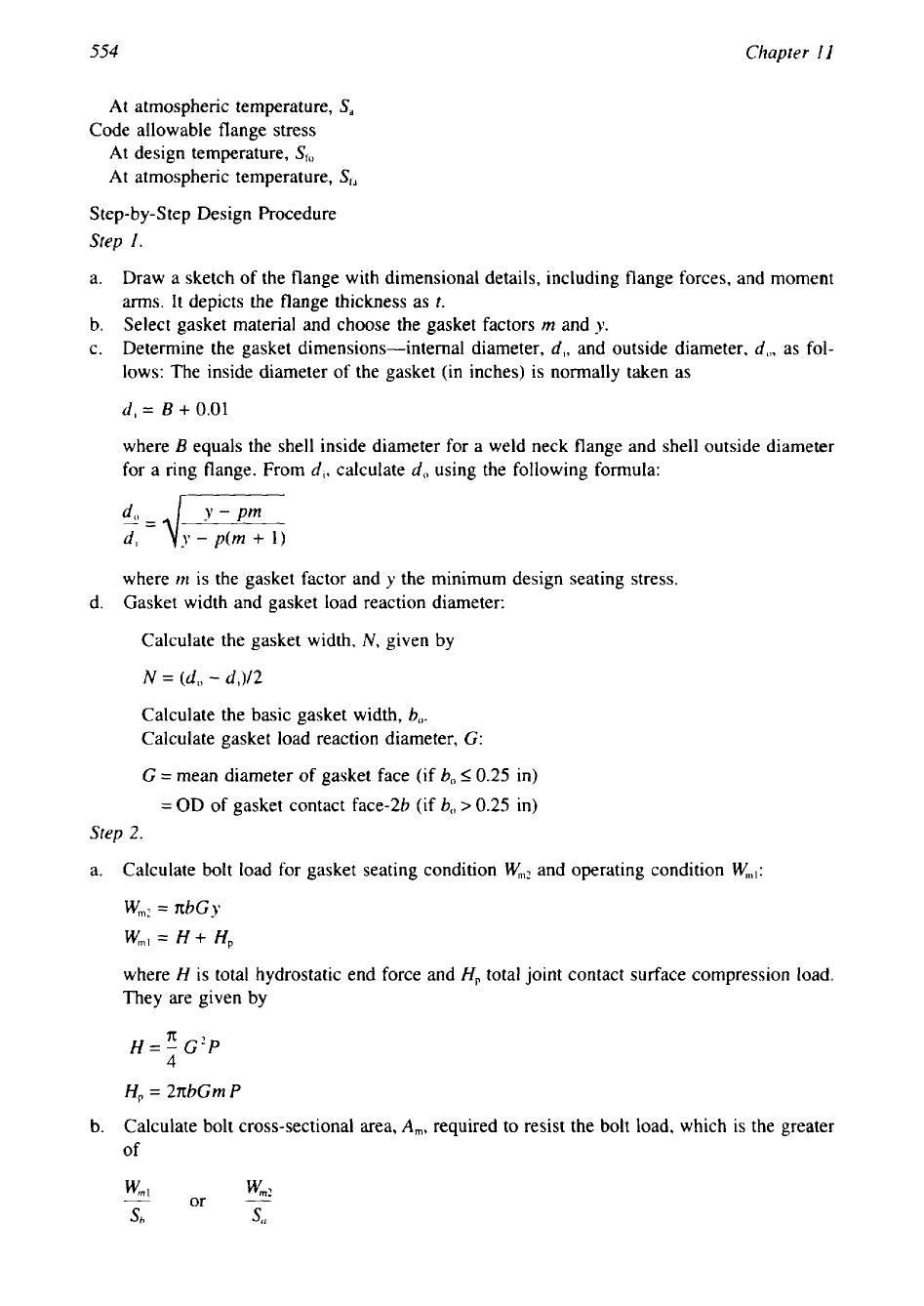
554
Chapter
I
I
At atmospheric temperature,
S,
Code allowable flange stress
At design temperature,
Sf,
At atmospheric temperature,
S,,,
Step-by-step Design Procedure
Step
1.
Draw a sketch of the flange with dimensional details, including
flange forces, and moment
arms.
It
depicts the flange thickness as
t.
Select gasket material and choose the gasket factors
m
and
y.
Determine the gasket dimensions-internal diameter,
d,,
and outside diameter,
d,,,
as fol-
lows: The inside diameter of the gasket (in inches)
is
normally taken as
d,
=
B
+
0.01
where
B
equals the shell inside diameter for a weld neck flange and shell outside diameter
for a ring flange. From
d,,
calculate
d,
using the following formula:
where
m
is the gasket factor and
y
the minimum design seating stress.
Gasket width and gasket load reaction diameter:
Calculate the gasket width,
N,
given by
N
=
(d”
-
dJ/2
Calculate the basic gasket width, b,.
Calculate gasket load reaction diameter, G:
G
=
mean diameter
of
gasket face (if b,
50.25
in)
=
OD
of gasket contact face-2b (if
b,
>
0.25
in)
Step
2.
Calculate bolt load for gasket seating condition
Wm7
and operating condition
Wm,:
Wmi
=
nbGy
Wml
=
H+
Hp
where H is total hydrostatic end force and
Hp
total joint contact surface compression load.
They are given by
Hp
=
27tbGmP
Calculate bolt cross-sectional area,
A,,,,
required to resist the bolt load, which is the greater
of
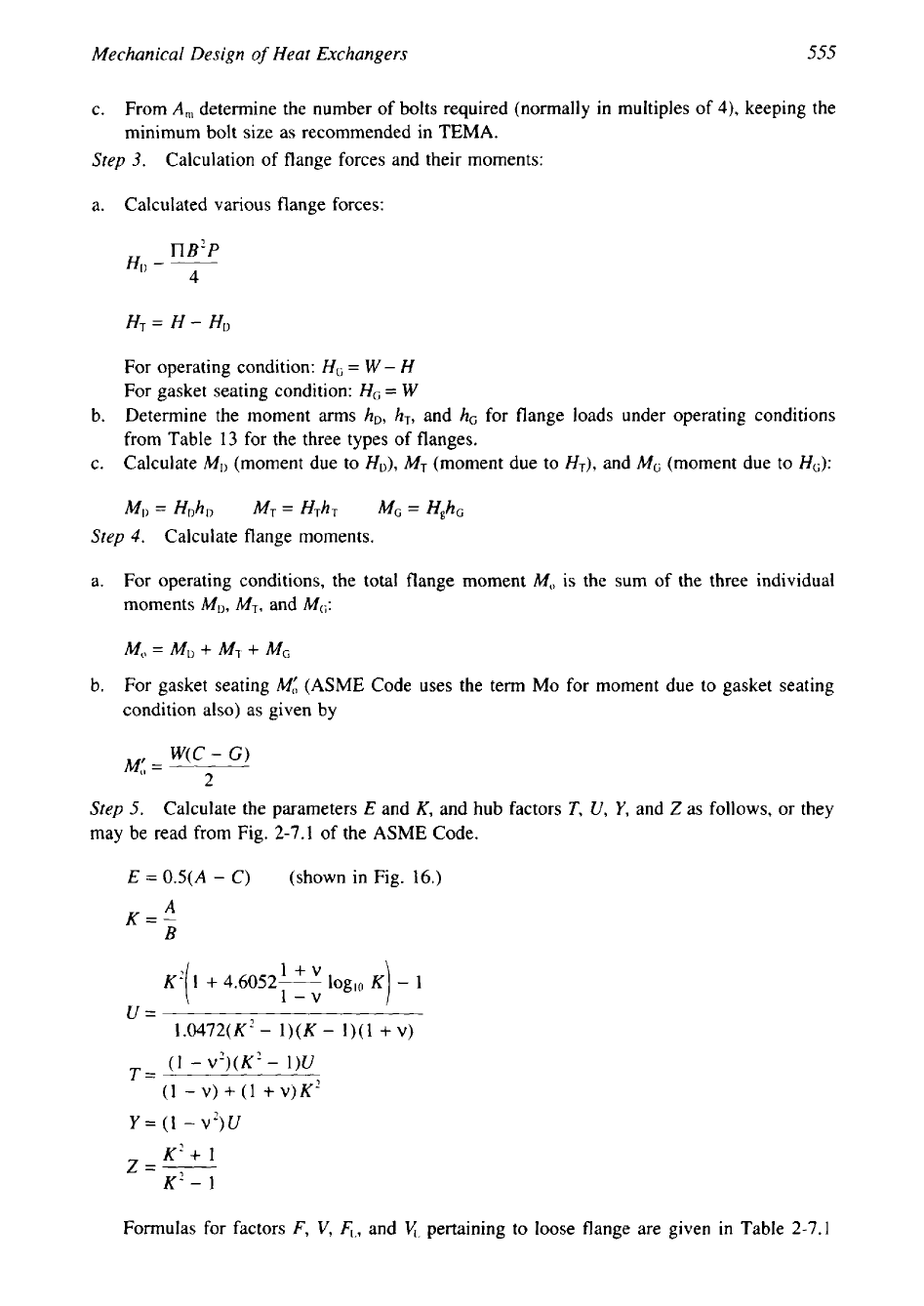
555
Mechanical Design
of
Heat Exchangers
c.
From
A,,,
determine the number of bolts required (normally in multiples of
4),
keeping the
minimum bolt size as recommended in TEMA.
Step
3.
Calculation of flange forces and their moments:
a. Calculated various flange forces:
For operating condition:
HG
=
W
-
H
For gasket seating condition:
HG
=
W
b.
Determine the moment
ms
hD, hT,
and
hG
for flange loads under operating conditions
from Table
13
for the three types of flanges.
c.
Calculate
MD
(moment due to
HD),
MT
(moment due to
HT),
and
MG
(moment due to
HG):
MU
=
HDhD
MT
=
HThT MG
=
HghG
Step
4.
Calculate flange moments.
a. For operating conditions, the total flange moment
M,,
is the sum of the three individual
moments
MD,
MT,
and
MG:
b.
For gasket seating
M;
(ASME
Code uses the term
MO
for moment due to gasket seating
condition also) as given by
W(C
-
G)
M,:
=
2
Step
5.
Calculate the parameters
E
and
K,
and hub factors
T,
U,
Y,
and
Z
as follows, or they
may be read from Fig.
2-7.1
of the
ASME
Code.
E
=
0S(A
-
C)
(shown in Fig.
16.)
1
+
4.6052-
l+v
log,,
K
-
1
--
1
-v
i
U=
1.0472(K2
-
1)(K
-
1)(1
+
V)
(1
-
v?>(K’-
1)U
T=
(1
-
V)
+
(1
+
v)K’
Y
=
(1
-
V2)U
Formulas for factors
F,
V,
FL,
and
VL
pertaining to loose flange are given
in
Table
2-7.1
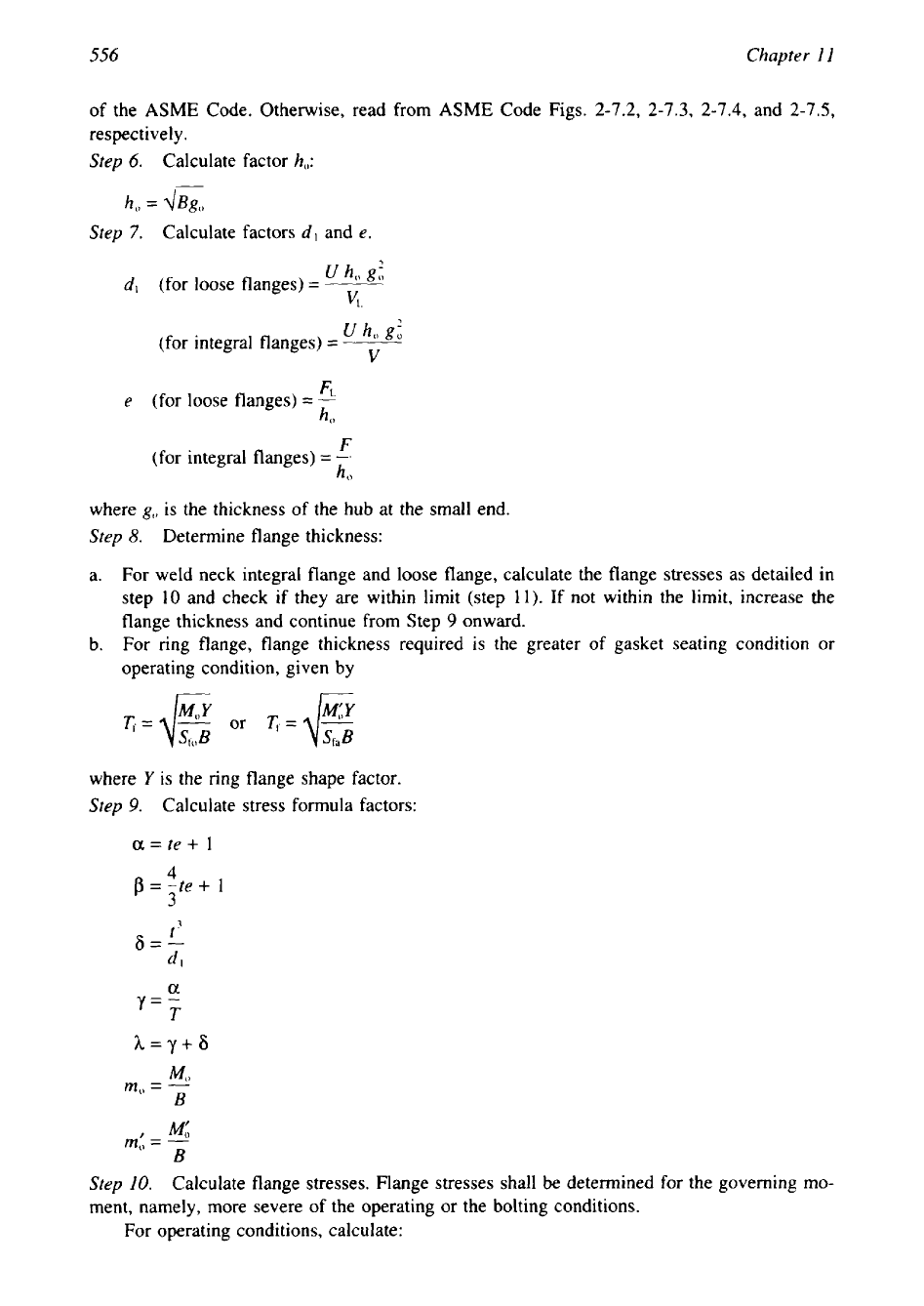
__
556
Chapter
11
of
the
ASME
Code. Otherwise, read from
ASME
Code Figs.
2-7.2, 2-7.3, 2-7.4,
and
2-7.5,
respectively.
Step
6.
Calculate factor
h,:
h,,
=
1IBg,,
Step
7.
Calculate factors
d,
and
e.
U
h"
gs
d,
(for loose flanges)
=
____
VL
U
ho
gs
(for integral flanges)
=
___
V
FL
e
(for loose flanges)
=
-
h
0
F
(for integral flanges)
=
-
h
0
where
g,,
is the thickness of the hub at the small end.
Step
8.
Determine flange thickness:
a.
For weld neck integral flange and loose flange, calculate the flange stresses as detailed in
step
10
and check if they are within limit (step
11).
If
not within the limit, increase the
flange thickness and continue from Step
9
onward.
b.
For ring flange, flange thickness required is the greater
of
gasket seating condition or
operating condition, given
by
where
Y
is the ring flange shape factor.
Step
9.
Calculate stress formula factors:
a=te+
1
4
p=-te+
1
3
a
y=-
T
MO
rn,)
=
-
B
I
K
rn,
=
-
B
Step
10.
Calculate flange stresses. Flange stresses shall
be
determined for the governing mo-
ment, namely, more severe of the operating or the bolting conditions.
For operating conditions, calculate:
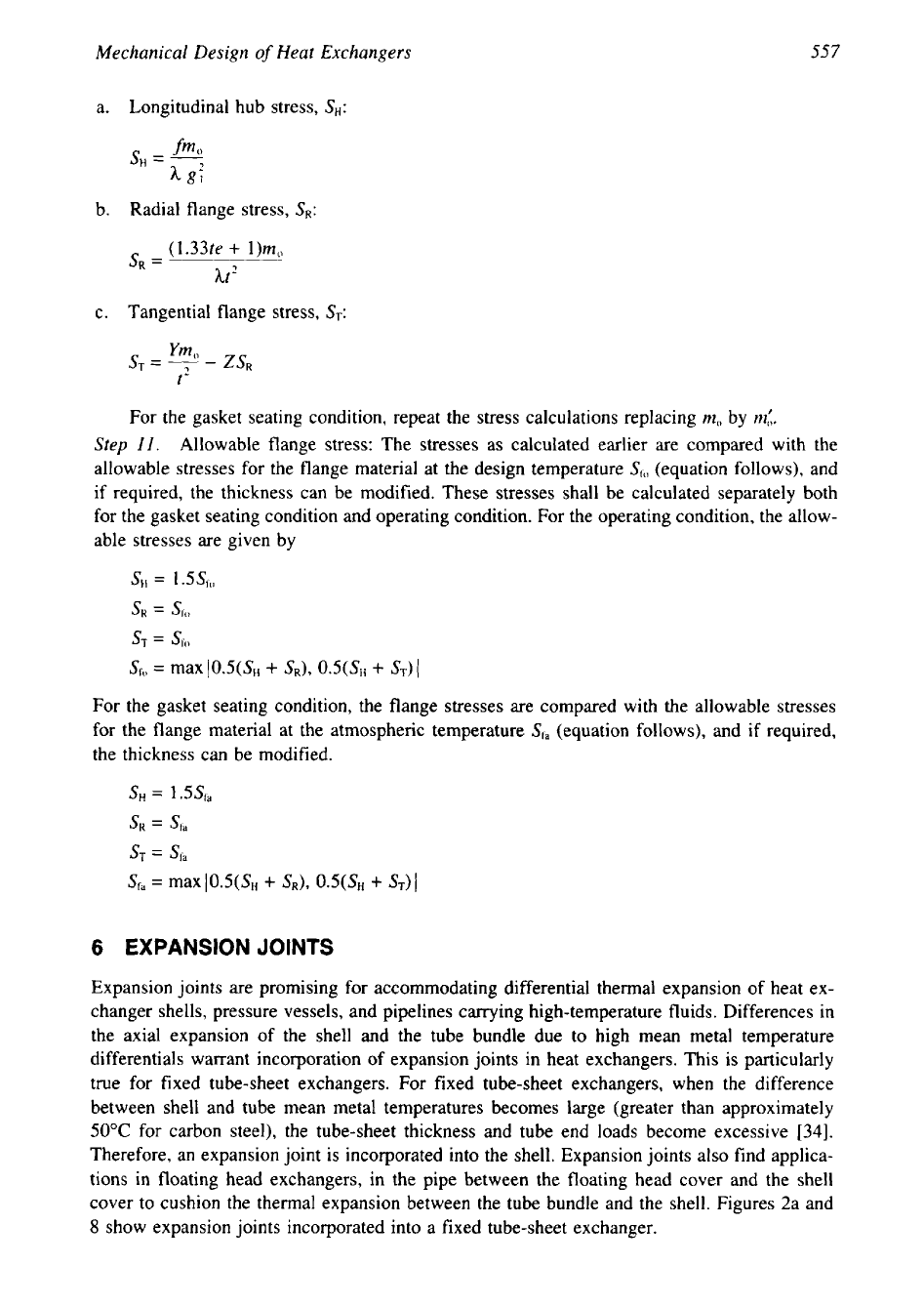
Mechanical Design
of
Hear Exchangers
557
Longitudinal hub stress,
SH:
Radial flange stress,
SR:
(1.33te
+
I)m,
SR
=
ht?
Tangential flange stress,
ST:
For the gasket seating condition, repeat the stress calculations replacing
m,
by
mi,
Step
II.
Allowable flange stress: The stresses as calculated earlier are compared with the
allowable stresses for the flange material at the design temperature
Sf,
(equation follows), and
if required, the thickness can be modified. These stresses shall be calculated separately both
for the gasket seating condition and operating condition. For the operating condition, the allow-
able stresses are given by
For the gasket seating condition, the flange stresses are compared with the allowable stresses
for the flange material at the atmospheric temperature
Sr,
(equation follows), and if required,
the thickness can be modified.
6
EXPANSION
JOINTS
Expansion joints are promising for accommodating differential thermal expansion of heat ex-
changer shells, pressure vessels, and pipelines carrying high-temperature fluids. Differences in
the axial expansion of the shell and the tube bundle due to high mean metal temperature
differentials warrant incorporation of expansion joints in heat exchangers. This is particularly
true for fixed tube-sheet exchangers. For fixed tube-sheet exchangers, when the difference
between shell and tube mean metal temperatures becomes large (greater than approximately
50°C
for carbon steel), the tube-sheet thickness and tube end loads become excessive
1341.
Therefore, an expansion joint is incorporated into the shell. Expansion joints also find applica-
tions in floating head exchangers, in the pipe between the floating head cover and the shell
cover to cushion the thermal expansion between the tube bundle and the shell. Figures 2a and
8
show expansion joints incorporated into a fixed tube-sheet exchanger.
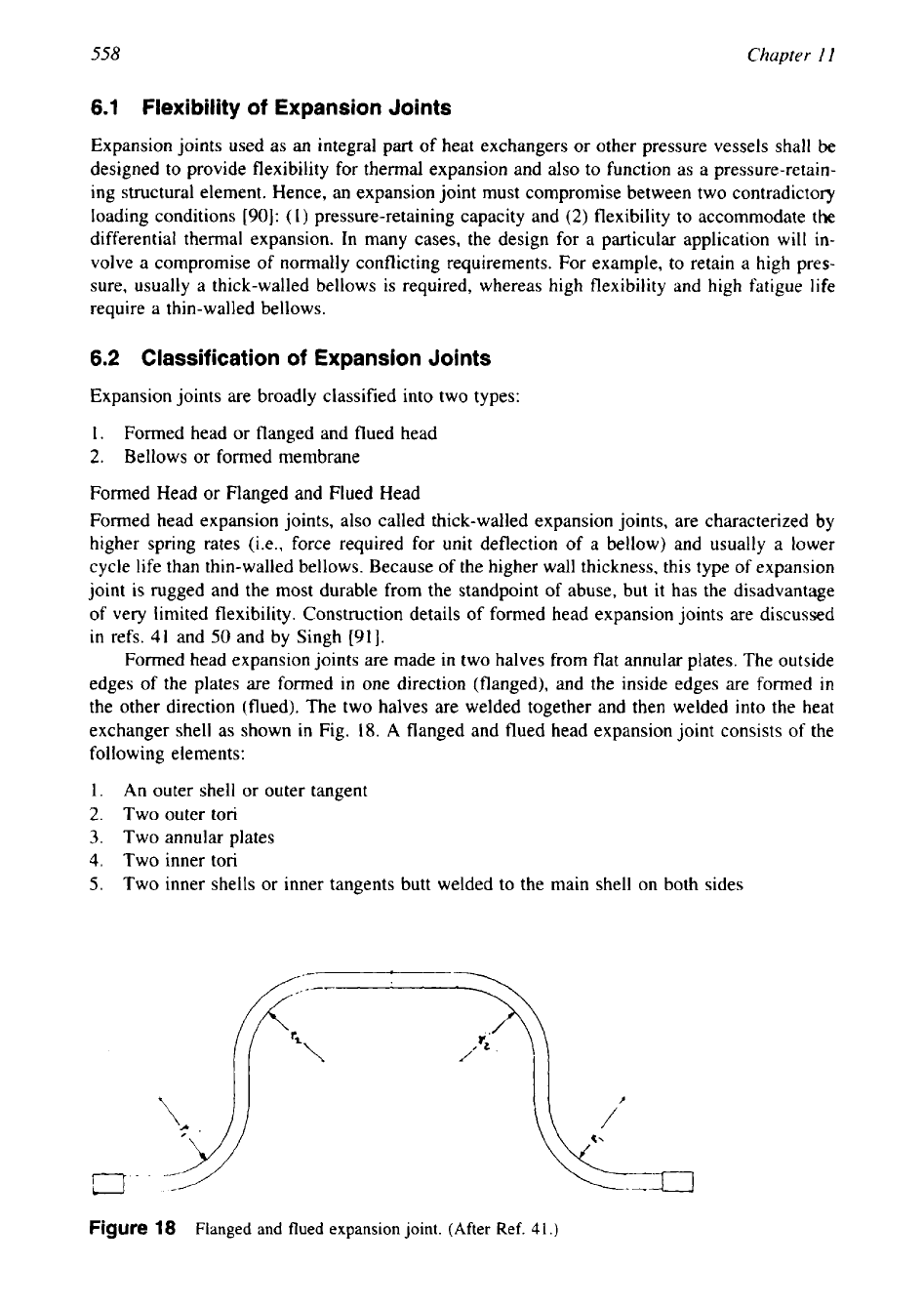
558
Chapter
I
I
6.1 Flexibility of Expansion Joints
Expansion joints used as an integral part of heat exchangers or other pressure vessels shall be
designed to provide flexibility for thermal expansion and also to function as a pressure-retain-
ing structural element. Hence, an expansion joint must compromise between two contradictory
loading conditions
[90]:
(
1)
pressure-retaining capacity and
(2)
flexibility to accommodate the
differential thermal expansion. In many cases, the design for a particular application will
in-
volve a compromise of normally conflicting requirements. For example, to retain a high pres-
sure, usually a thick-walled bellows is required, whereas high flexibility and high fatigue life
require a thin-walled bellows.
6.2
Classification of Expansion Joints
Expansion joints are broadly classified into two types:
1.
Formed head or flanged and flued head
2.
Bellows or formed membrane
Formed Head or Flanged and Flued Head
Formed head expansion joints, also called thick-walled expansion joints, are characterized by
higher spring rates (i.e., force required for unit deflection of a bellow) and usually a lower
cycle life than thin-walled bellows. Because of the higher wall thickness, this type of expansion
joint is rugged and the most durable from the standpoint of abuse, but it has the disadvantage
of very limited flexibility. Construction details of formed head expansion joints are discussed
in refs. 41 and
50
and by Singh
[91].
Formed head expansion joints are made in two halves from flat annular plates. The outside
edges of the plates are formed
in
one direction (flanged), and the inside edges are formed
in
the other direction (flued). The two halves are welded together and then welded into the heat
exchanger shell as shown in Fig.
18.
A
flanged and flued head expansion joint consists of the
following elements:
1.
An outer shell or outer tangent
2.
Two outer tori
3.
Two annular plates
4.
Two inner tori
5.
Two inner shells or inner tangents butt welded to the main shell on both sides
Figure
18
Flanged and flued expansion joint.
(After
Ref.
41
.)
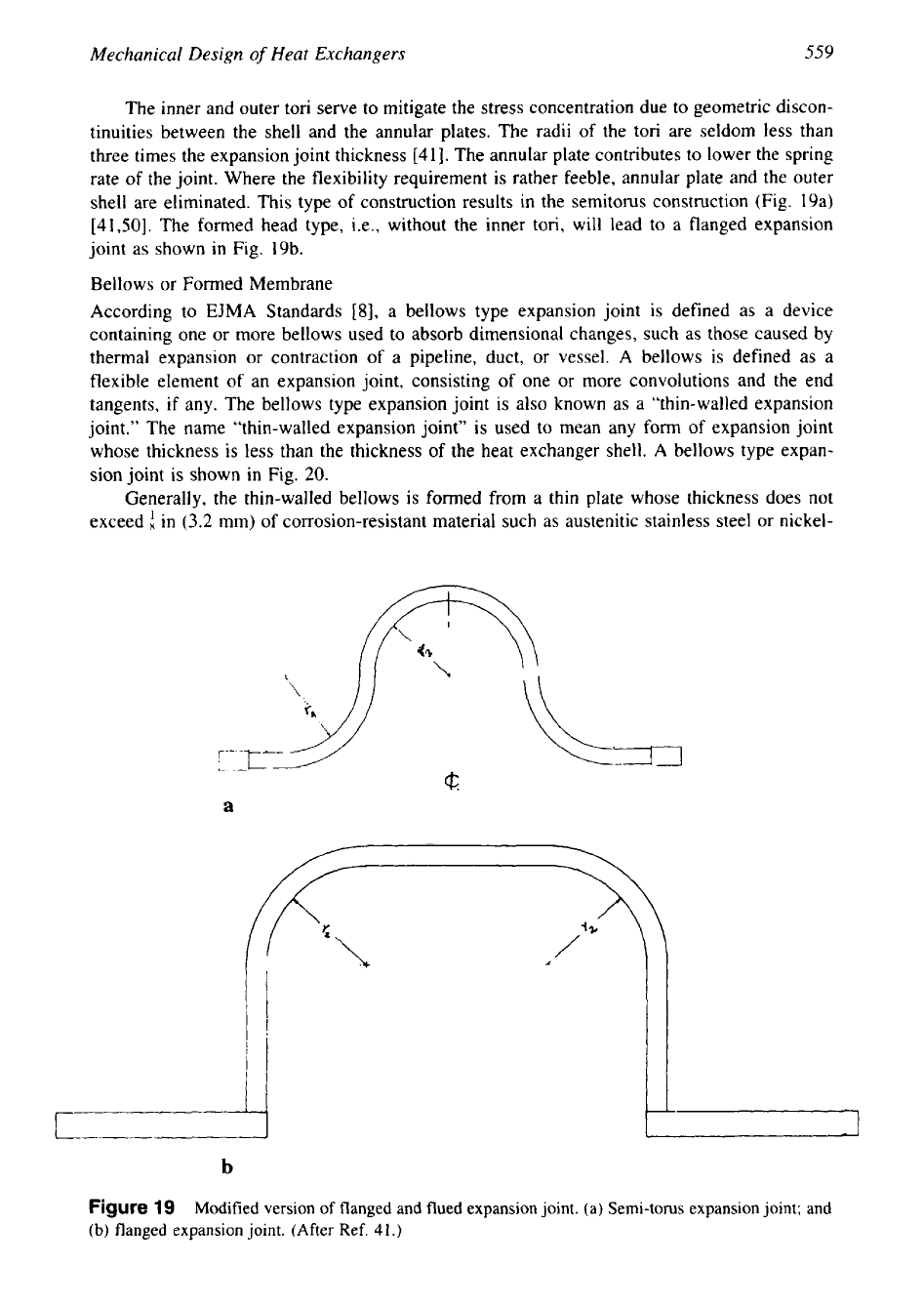
559
Mechanical Design
of
Heat
Exchangers
The inner and outer tori serve to mitigate the stress concentration due to geometric discon-
tinuities between the shell and the annular plates. The radii of the tori are seldom less than
three times the expansion joint thickness [41]. The annular plate contributes to lower the spring
rate of the joint. Where the flexibility requirement is rather feeble, annular plate and the outer
shell are eliminated. This type of construction results in the semitorus construction (Fig. 19a)
[41,50].
The formed head type, i.e., without the inner tori, will lead to a flanged expansion
joint as shown in Fig. 19b.
Bellows or Formed Membrane
According to EJMA Standards
[8],
a bellows type expansion joint is defined as a device
containing one or more bellows used to absorb dimensional changes, such as those caused by
thermal expansion or contraction of a pipeline, duct, or vessel. A bellows is defined as a
flexible element of an expansion joint, consisting of one or more convolutions and the end
tangents,
if
any. The bellows type expansion joint is also known as a “thin-walled expansion
joint.” The name “thin-walled expansion joint” is used to mean any form of expansion joint
whose thickness is less than the thickness
of
the heat exchanger shell.
A
bellows type expan-
sion joint is shown in Fig.
20.
Generally, the thin-walled bellows is formed from a
thin
plate whose thickness does not
exceed in
(3.2
mm) of corrosion-resistant material such as austenitic stainless steel
or
nickel-
a
b
Figure
19
Modified version
of
flanged and flued expansion joint. (a) Semi-toms expansion joint; and
(b)
flanged expansion joint.
(After
Ref.
41.)
i
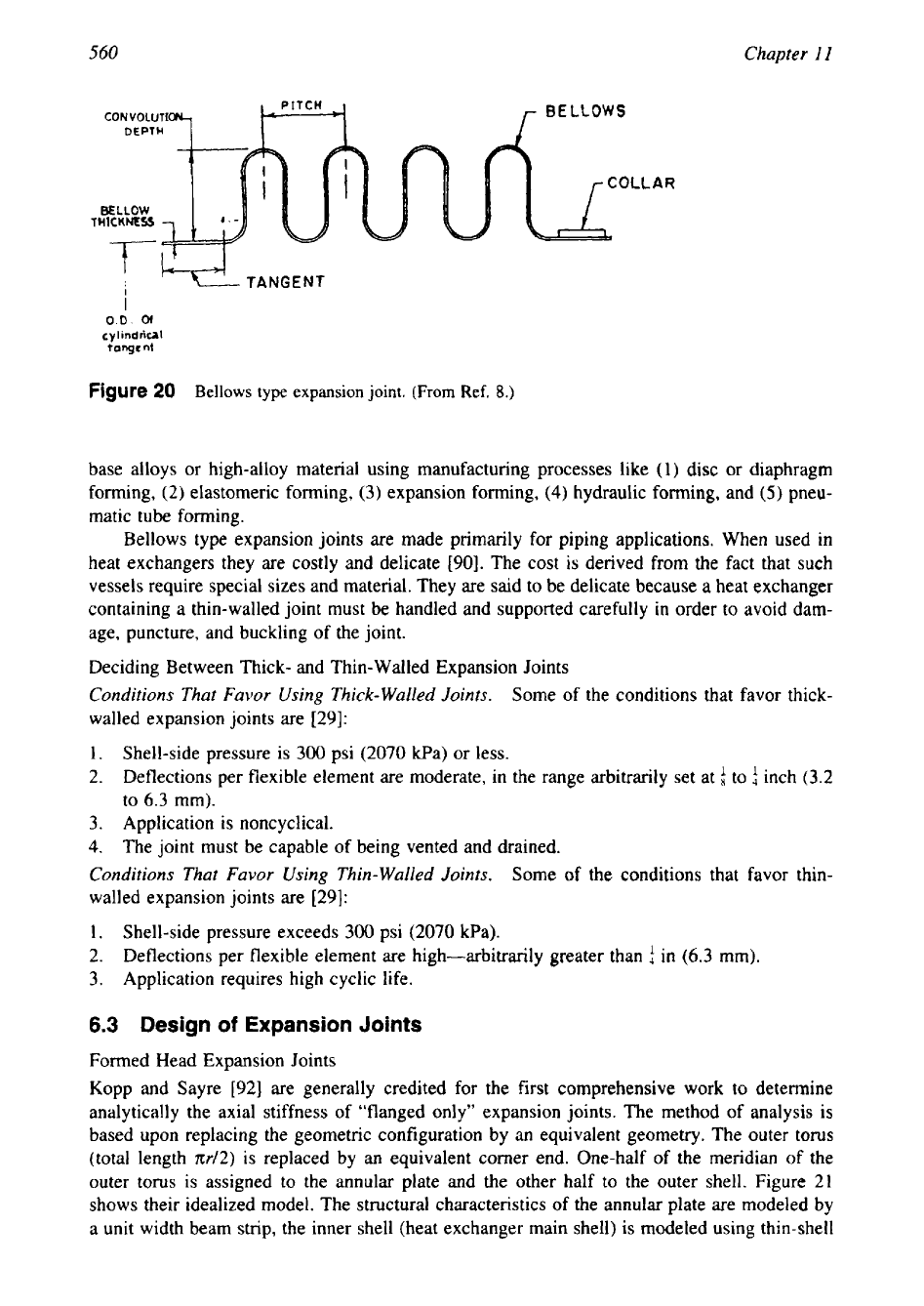
560
Chapter
11
UAR
0.0.
a
c
y
I
ind
do1
tangent
Figuie
20
Bellows type expansion
joifit.
(From
Ref.
8.)
base alloys or high-alloy material using manufacturing processes like
(I)
disc or diaphragm
forming,
(2j
elastomeric forming,
(3)
expansion forming,
(4)
hydraulic forming, and
(5)
pneu-
matic tube forming.
Bellows type expansion joints are made prirnauily for piping applications, When used in
heat exchangers they are costly md delicate [90]. The cost is derived from the fact that such
vessels require special sizes and material. They
are
said
to
be delicate because
a
heat exchanger
containing a thin-walled joint must be handled and supported carehlly
in
order to avoid dam-
age, puncture, and buckling of the joint.
Deciding Between Thick- and Thin-Walled Expansion Joints
Conditions That Favor Using Thick-Walled Joints.
Some
of
the conditions that favor thick-
walled expansim joints are [29]:
1.
Shell-side pressure is
300
psi (2073 Wa) or less.
2. Deflections per flexible element are moderate, in the range arbitrarily
set
at
fi
to
i
inch
(3.2
to
6.3
mmj.
3.
Application is noncyc!ical.
4.
The joint must be capable of being vented and drained.
Conditions That Favor
Using
Thin-Walled Joints.
Some
i;f
the conditions that favor thin-
walled expansion joints are [29]:
1.
Shell-side pressure exceeds
300
psi (2070 kPa).
2.
Deflections per flexible element are high-arbitrarily greater than in
(6.3
mmj.
3.
Application requires high cyclic life.
6.3
Design
of
Expansion
Joints
Formed Head Expansion Joints
Kopp and Sayre
[S2]
are generally credited for the first comprehensive work
to
determine
analytically the axial stiffness
of
“flanged only” expansion joints. The method of analysis is
based upon replacing the geometric configuration by
an
equivalent geometry. The outer torus
(total length xr/2j is replaced by
it2
equivalent corner end. One-half of the meridian of the
outer torus is assigned
to
the annular plate and the other half to the outer sheii. Figure
21
shows their idealized model. The structural characteristics of the annular plate are modeled by
a unit width beam strip, the inner shell (heat exchanger main shell)
is
modeled using thin-shell
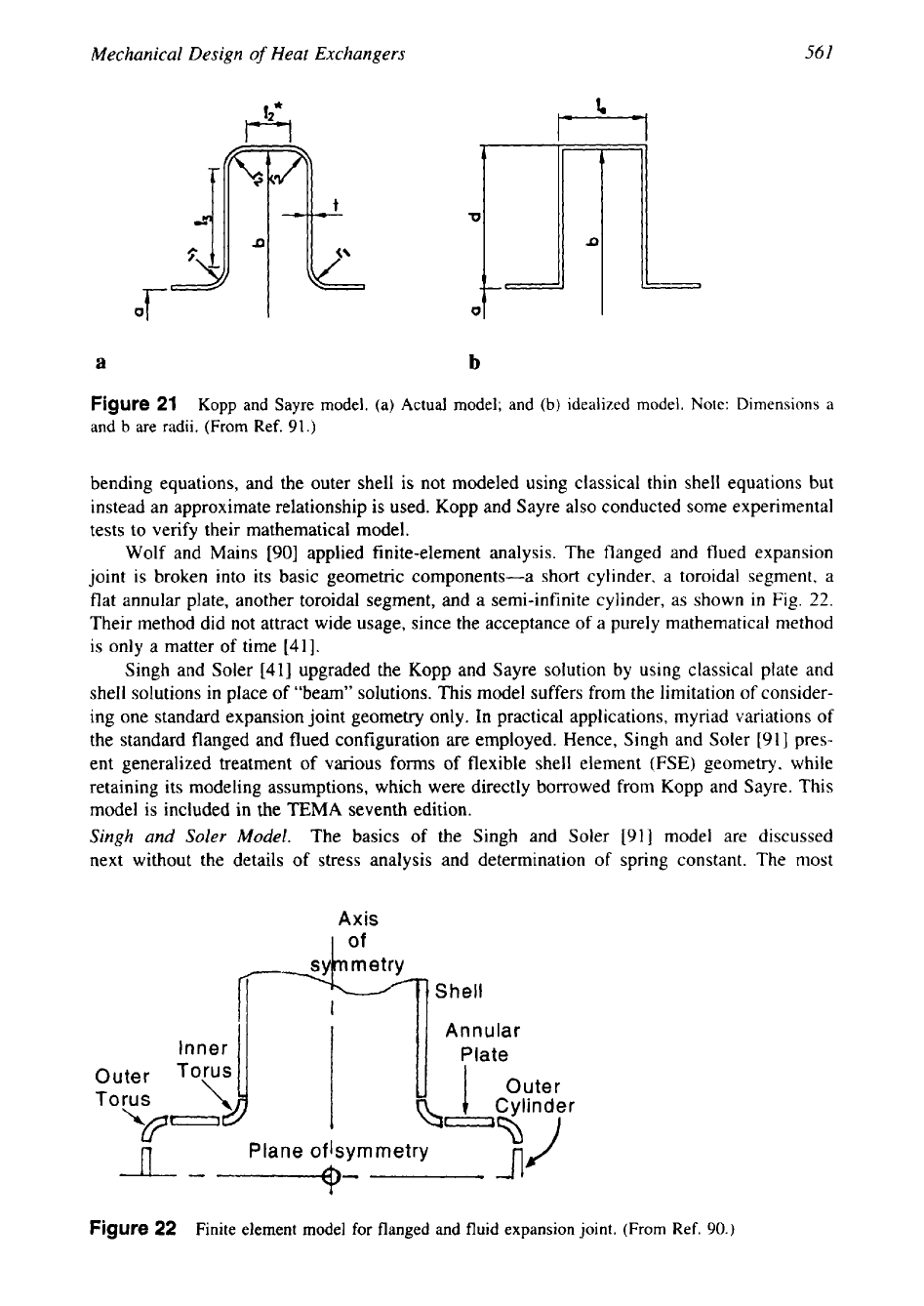
--
561
Mechanical Design
of
Heat Exchangers
a
b
Figure
21
Kopp and Sayre model. (a)
Actual
model; and
(b)
idealized model.
Note:
Dimensions
a
and
b
are radii. (From Ref.
91.)
bending equations, and the outer shell is not modeled using classical thin shell equations but
instead an approximate relationship is used. Kopp and Sayre also conducted some experimental
tests to verify their mathematical model.
Wolf and Mains
[90]
applied finite-element analysis. The flanged and flued expansion
joint is broken into its basic geometric components-a short cylinder, a toroidal segment, a
flat annular plate, another toroidal segment, and a semi-infinite cylinder, as shown
in
Fig.
22.
Their method did not attract wide usage, since the acceptance
of
a purely mathematical method
is only
a
matter
of
time
[41].
Singh and Soler
[41]
upgraded the Kopp and Sayre solution by using classical plate and
shell solutions
in
place
of
“beam” solutions. This model suffers from the limitation
of
consider-
ing one standard expansion joint geometry only. In practical applications, myriad variations
of
the standard flanged and flued configuration are employed. Hence, Singh and Soler
[91]
pres-
ent generalized treatment
of
various
forms
of flexible shell element
(FSE)
geometry, while
retaining its modeling assumptions, which were directly borrowed from
Kopp
and Sayre. This
model is included in the
TEMA
seventh edition.
Singh and Soler Model.
The basics
of
the Singh and Soler
[91]
model are discussed
next without the details of stress analysis and determination of spring constant. The most
Axis
I
1
Annular
Plate
I
Outer
Plane oflsymmetry
A,
Figure
22
Finite element model for flanged and fluid expansion joint. (From Ref.
90.)
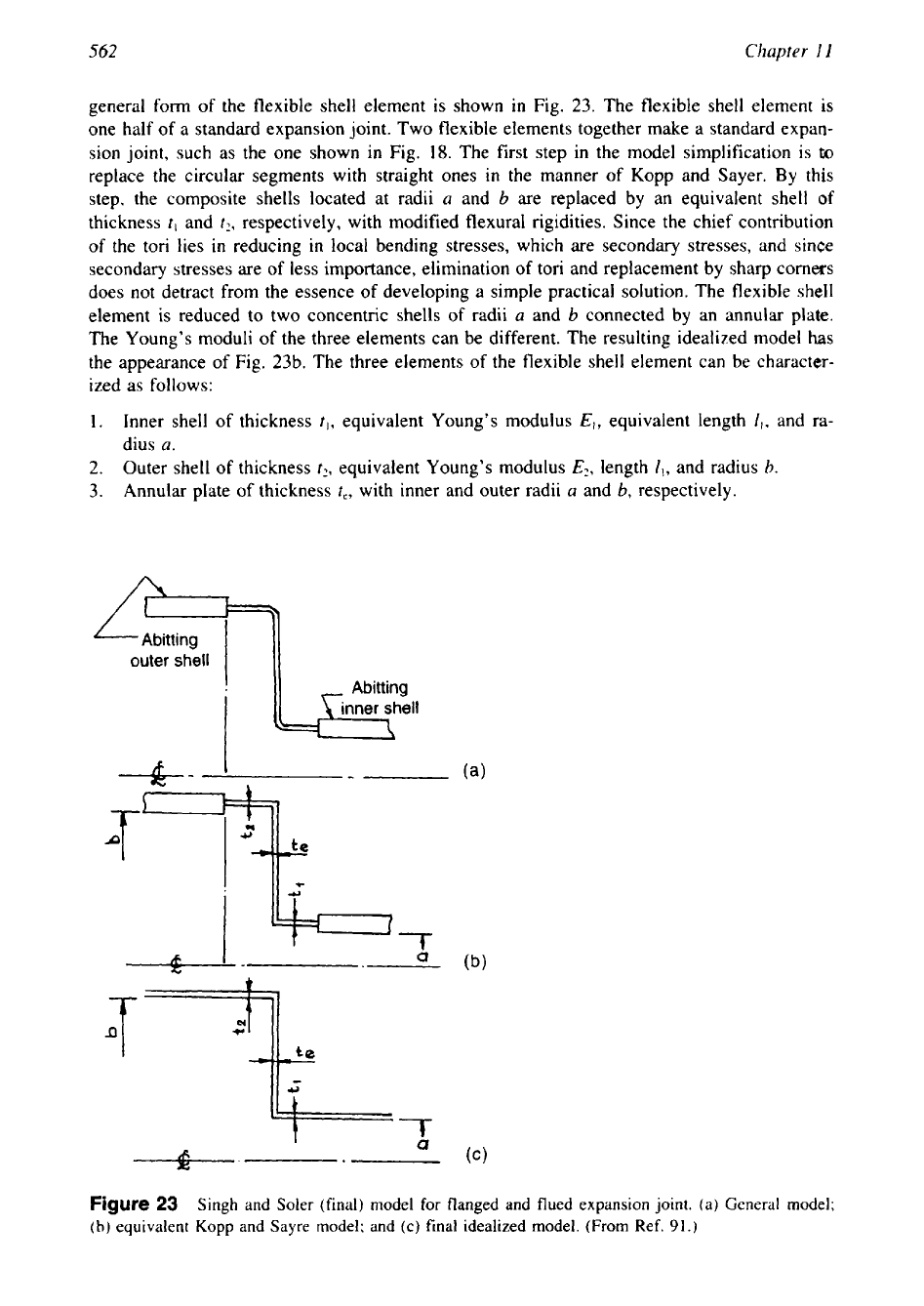
562
Chapter
11
general form of the flexible shell element is shown in Fig. 23. The flexible shell element
is
one half of a standard expansion joint. Two flexible elements together make a standard expan-
sion joint, such as the one shown in Fig.
18.
The first step in the model simplification is
to
replace the circular segments with straight ones
in
the manner of Kopp and Sayer. By this
step. the composite shells located at radii
a
and
b
are replaced by an equivalent shell of
thickness
t,
and
tl,
respectively, with modified flexural rigidities. Since the chief contribution
of the tori lies
in
reducing in local bending stresses, which are secondary stresses, and since
secondary stresses are of less importance, elimination of tori and replacement by sharp corners
does not detract from the essence of developing a simple practical solution. The flexible shell
element is reduced to two concentric shells
of
radii
a
and
b
connected by an annular plate.
The Young's moduli of the three elements can be different. The resulting idealized model
has
the appearance of Fig. 23b. The three elements of the flexible shell element can be charactcr-
ized as follows:
1.
Inner shell of thickness
t,,
equivalent Young's modulus
E,,
equivalent length
I,,
and ra-
dius
a.
2.
Outer shell
of
thickness
t,,
equivalent Young's modulus
E:,
length
I,,
and radius
6.
3.
Annular plate of thickness
t,,
with inner and outer radii
a
and
b,
respectively.
-
Abitting
outer
shell
!
-4--
I .
I
a
&(
Figure
23
Singh and Soler (final) model
for
flanged and flued expansion joint. (a) General model;
(b)
equivalent Kopp and Sayre model; and
(c)
final idealized model.
(From
Ref.
91.)
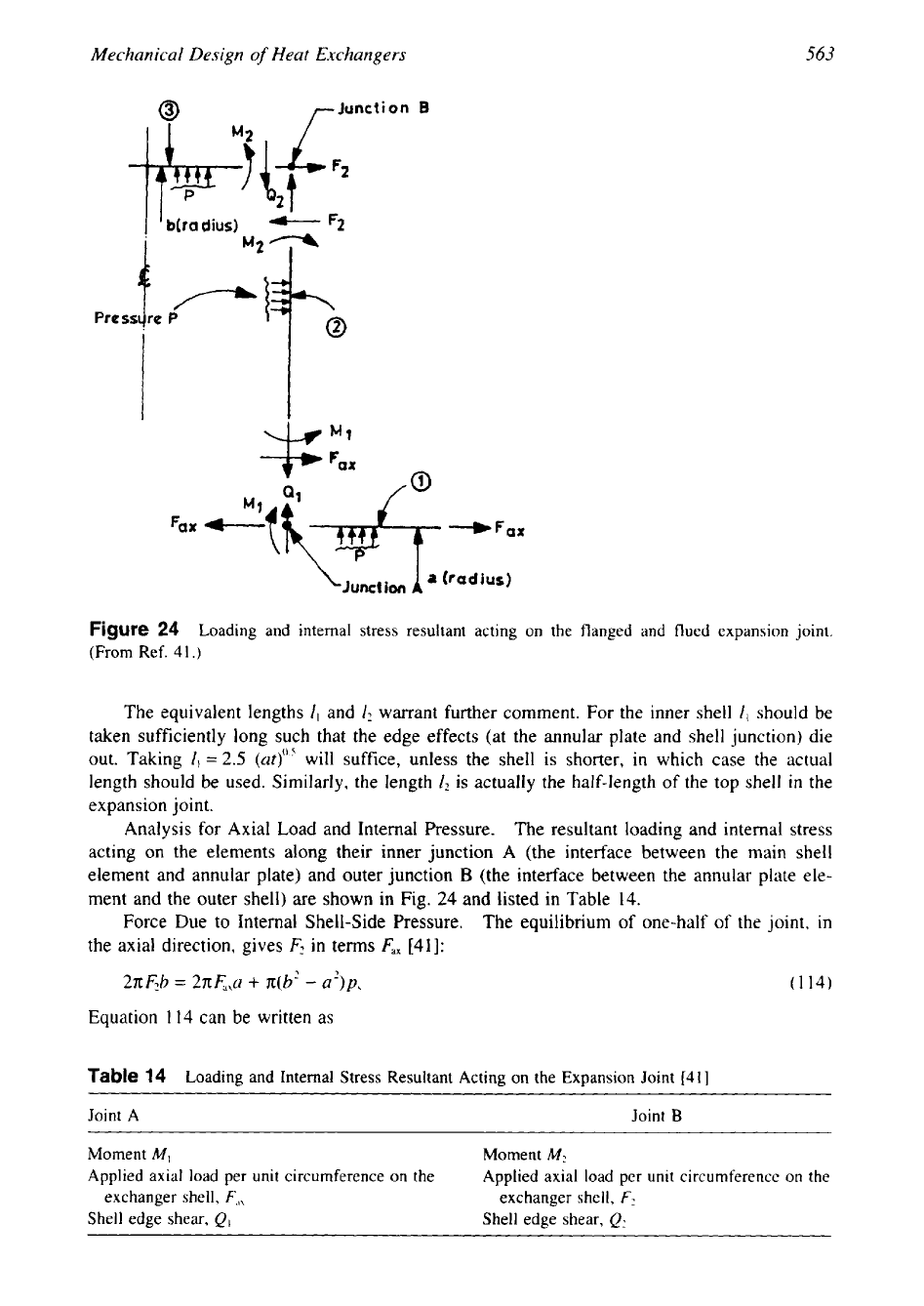
563
Mechanical Design
of
Heat Exchangers
,-Junction
B
0
I
'blrodius)
F2
\-Junction
1
a
(radius)
Figure
24
Loading and internal stress resultant acting on the flanged and flued expansion joint.
(From Ref.
41.)
The equivalent lengths
I,
and
I?
warrant further comment. For the inner shell
I,
should be
taken sufficiently long such that the edge effects (at the annular plate and shell junction) die
out. Taking
I,
=
2.5
(ut)O5
will suffice, unless the shell is shorter, in which case the actual
length should be used. Similarly, the length
Z2
is actually the half-length of the top shell
in
the
expansion joint.
Analysis for Axial Load and Internal Pressure. The resultant loading and internal stress
acting on the elements along their inner junction
A
(the interface between the main shell
element and annular plate) and outer junction
B
(the interface between the annular plate ele-
ment and the outer shell) are shown in Fig.
24
and listed in Table
14.
Force Due to Internal Shell-Side Pressure. The equilibrium of one-half of the joint,
in
the axial direction, gives
F2
in
terms
F,,
[41]:
2nfib
=
2nF,,a
+
n(b'
-
a')p,
(1
14)
Equation
114
can be written as
Table
14
Loading and Internal Stress Resultant Acting on the Expansion Joint
[41]
Joint
A
Joint
B
Moment
M,
Moment
M,
Applied axial load per unit circumference on the
Applied axial load per unit circumference
on
the
exchanger shell,
F,,,
exchanger shell,
F.
Shell edge shear,
Q,
Shell edge shear,
Q.
